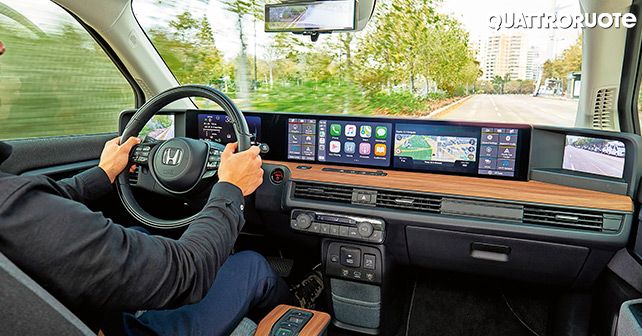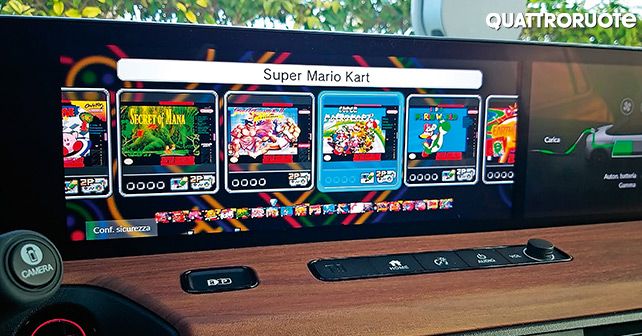Retro in styling and futuristic in technology – the Honda e comes with five screens, taking the very idea of multimedia to a different level. It offers brilliant driving experience, even around corners, however, it falls short in terms of real-world driving range, which is less than 200 kilometres.
There are only a handful of cars that can be considered to have marked a ‘before’ and an ‘after’ period in the history of a manufacturer. The Honda e is undoubtedly a car that belongs to this elite category. Not only because it’s all set make its debut in a time that is historically significant, but also because of the features, it brings to market. In the words of the Japanese technicians, ‘it anticipates the market by ten years.’
But, before we talk about them, it would be interesting to see how this little electric car uses the eyes of the past to look at the future. We are not exaggerating! Just look at the round headlights – they are clearly a reference to its illustrious ancestors, such as the N360 and the Civic first series from 1967 and 1972, respectively. So, a lot of affection for the past and well-defined lines are condensed in its bumper-to-bumper length of 3,900mm – around 100mm less than that of the Jazz.
Virtual is the New Real
Okay, let’s begin! The moment you enter into the cockpit of the Honda e, you realise how it takes a giant leap into the future in terms of technological advancements. The dashboard sports five screens – yes, you read that right! – which include two ORVMs, an instrument panel, and two multimedia systems.
It’s a true paradise for those who like to spend time in front of a screen. Just imagine the possibilities – you no longer have to endure the boredom of waiting while its batteries are charged. You simply turn that time into a quick gaming session by connecting your Nintendo to the HDMI port, or you can simply take that time to enjoy the latest episode of your favourite show.
The two 12.3-inch displays sit at the centre of the dashboard, which offers you an option to choose your favourite layout and display an unusual screensaver – a kind of virtual aquarium, full gliding marine life, which switches off automatically during driving to avoid distractions.
In practical terms, people will take some time to acclimatise to the overwhelming presence of technology – you can’t, after all, hope to find the right function at the first go while you’re busy driving! Similarly, it will also take some time to get in tune with the two six-inch displays – a modern reinterpretation of classic exterior mirrors – at both sides of the dashboard. And while we’re at it, there’s also a risk of inaccurately evaluating the exact distance between your car and other vehicles.
That said, it’s nice to see that the maniacal care and attention to detail that has gone into making the interior has not affected Honda’s commitment towards its dynamic qualities – in other words, the Honda e drives brilliantly.
Based on a new zero-emission platform, which will be the basis for future electric models of the Japanese manufacturer, the Honda e features an electric motor at the rear (and therefore is a rear-wheel-drive car). The battery pack is placed exactly under the cockpit, which allows for a perfect 50:50 weight distribution and a low centre of gravity.
Now, to all this, add MacPherson strut independent suspension all around, a steering wheel that allows you to follow the folds and creases of the tarmac quite faithfully – even when they take place at intersections, traffic lights, pedestrian crossings and pavements – and, then, season the whole thing with pleasant responsiveness, and what you get is a perfect cocktail. Not to mention, thanks to the small turning radius, u-turns are a piece of cake for this small electric.
Despite all this, the little more than 180 kilometres that it offers on a full charge is, at the end of the day, is somewhat limited. Even though it was conceived and built to remain strictly within the city, this little Honda has credentials to face a wide variety of suburban conditions with ease. So, a limited range of kilometres means that you won’t be able to unleash or enjoy its full potential.
On the highway, there is almost an absolute lack of wind noise, and the few decibels that do filter into the cabin are the result of the wheels cutting through the air. In short, you always feel at home, thanks to the warm wood on the dashboard and central tunnel, the flat floor (front), and the fabrics used to cover the seats. In other words, the cockpit is a great place to spend some time in, even when you’re stuck in traffic at rush hour.
Talking of being stuck in traffic, it can be a good opportunity to experiment with the potential of the voice assistance system, which can be activated by saying, ‘OK, Honda.’ If you don’t find that interesting enough, you can also check out the four levels of regenerative braking – not only can this operation be performed by a paddle behind the steering wheel, but also by pressing a special button on the central tunnel, which allows you to literally forget the brakes. Also, during stops at traffic lights, the system keeps the car stationary until the right pedal is pressed to start it again.
The price for this Advance version starts at 38,500 Euros (approximately ₹31 lakh). True, the price is a bit on the expensive side, even when we consider the fact that the car offers quite a comprehensive set of equipment.
In terms of driver assistance, the car offers adaptive cruise control, lane-keeping, and traffic sign recognition as standard. If you want to save money, there’s a basic version with 135 horsepower and 220 kilometres of claimed range, and it costs 3,000 Euros (approximately ₹2.4 lakh) less. It was supposed to arrive at the dealership in European markets at the end of May, but given the Coronavirus scare, its launch will be delayed.
Instead of exterior mirrors, there are two small cameras, which display images on two 6-inch screens on both sides of the dashboard. According to Honda, this minimises noise in the cockpit and increases visibility in the rain – a water-repellent film has been applied to the lenses. To minimise blind spots, the camera view has two levels – normal and wide.
The pictures on the left offer an idea of what the infotainment is capable of – it consists of two 12.3-inch touchscreens. Thanks to the HDMI socket, you can also plug in a video game console. Below, there are ADAS management (Advanced Driver Assistance Systems) and voice assistance systems – when the system is listening, just say ‘OK, Honda’, and a stylised face will appear on the screen.
- Honda e Advance
Motor: Electric permanent magnet synchronous motor
Battery: Lithium-ion, 35.5kWh
Transmission: Fixed-ratio gearbox / Rear-wheel drive
Power: 113kW(152bhp)
Torque: 315Nm
Acceleration: 0 - 100km/h - 8.3s
Top Speed: 145km/h
Range (claimed): 210km
Dimensions & weight:
Wheelbase: 2,530mm
Length x Width x Height: 3,900mm x 1,750mm x 1,510mm
Weight: 1,542kgs
© Riproduzione riservata
Also read,
Carlos Ghosn's diabolical rebuttal against Nissan & the Japanese judicial system
































Write your Comment